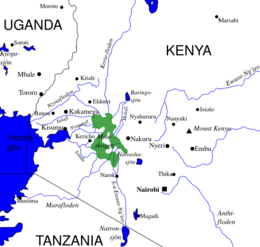Mau Forest
Mau Forest is a forest complex in the Rift Valley of Kenya. It is the largest indigenous montane forest in East Africa. The Mau Forest complex has an area of 273,300 hectares (675,000 acres).[1]

The forest area has some of the highest rainfall rates in Kenya.[1] Mau Forest is the largest drainage basin in Kenya.[2] Numerous rivers originate from the forest, including Southern Ewaso Ng'iro, Sondu River, Mara River and Njoro River. These rivers feed Lake Victoria, Lake Nakuru and Lake Natron.[1] Western slopes of the Mau Escarpment are covered by Mau Forest.[1]
Ecology
Typical tree species in Mau Forest include Pouteria adolfi-friedericii, Strombosia scheffleri and Polyscias kikuyuensis. Olea capensis, Prunus africana, Albizia gummifera and Podocarpus latifolius are also found there.[1]
Endemic bird species in the area include Hartlaub's turaco (Tauraco hartlaubi), Hunter's cisticola (Cisticola hunteri) and Jackson's spurfowl (Pternistis jacksoni).[1]
Destruction
The forest has been traditionally inhabited by Ogiek people, whose hunter-gatherer lifestyle is sustainable.[1] However, due to immigration from other ethnic groups, large parts of the forest area have been cleared for settlement.[1] Human activities, especially logging, have led to deforestation of more than a quarter of the area since 1973.[3][4] This is due to increased charcoal trade in places like Narok town and suppy of logs to saw mills in Baringo, Nakuru and Narok counties.[5]
In 2008, the inauguration of the Sondu-Miriu hydro power plant was postponed due to low water levels, that are said to be resulting from the destruction of Mau Forest.[2]
Mau Forest evictions
In summer 2008 there was a political row over resettlement of people, who had been allocated land there during the KANU era during the 1980s and 1990s. Some of the settlers are famed politicians, like Franklin Bett and Zakayo Cheruiyot. In 2004 Paul Ndung’u released "Ndungu Report", which listed these land allocations, terming them illegal and recommended revocation of them.[2] Some evictions were implemented between 2004 and 2006, without a resettlement scheme.[6]
On July 15, 2008, Prime minister Raila Odinga issued an order that these evictions to be implemented by October 2008 in order to protect the forest from destruction.[7] The order has been opposed by number of Rift Valley area politicians, led by Isaac Ruto. Some politicians, led by Minister of Agriculture William Ruto, propose that if evictions are implemented, the government should allocate them land elsewhere.[2]
The evictions began in November 2009. Some prominent people are set to lose their land, including family members of former president Daniel arap Moi.[8] Also under threat is the Kiptagich Tea Factory owned by former president Moi.[9]
References
- BirdLife IBA Factsheet
- Daily Nation, July 22, 2008: Selfish interests threaten Mau forest Archived 2008-11-23 at the Wayback Machine
- Kanyinke Sena. "MauForest: Killing the goose but still wanting the golden eggs" (PDF). IWGIA.
- http://www.ku.ac.ke/schools/engineering/images/stories/docs/publications/land_degredation_mau.pdf
- "Charcoal trade, logging wiping out Mau Forest". Daily Nation. Retrieved 2020-02-18.
- Amnesty International: Kenya Nowhere to go: Forced Evictions in Mau Forest Briefing Paper, May 2007
- Capital News, July 15, 2008:Raila meeting endorses Mau evictions Archived 2011-07-22 at the Wayback Machine
- Daily Nation, November 28, 2009: Big names and soldiers next in Mau crackdown
- Daily Nation, December 22, 2009: MP vows to fight Moi eviction bid
External links
- Mau Forest Restoration Interim Coordinating Secretariat (2010). "Restoration of the Mau Forest Ecosystem". Archived from the original on 20 May 2010.
- "Mau Forest Community Association (MACOFA)". 2007. Archived from the original on 5 December 2007.